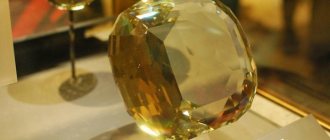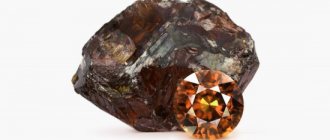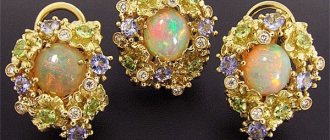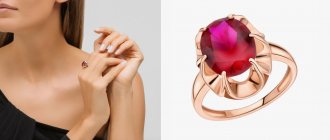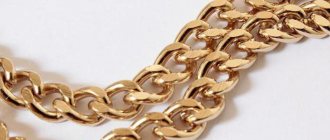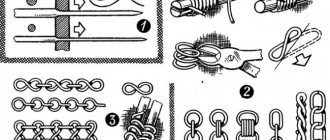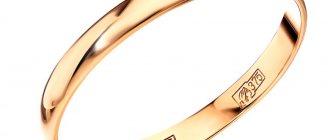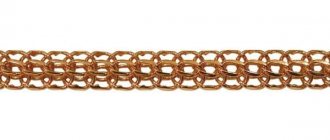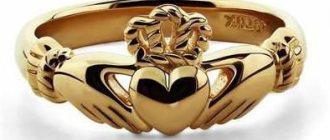History of the stone
Alexandrite was first found in 1833 in the Urals, mistaking it for an emerald. The thing is that in daylight this stone has a green color. Imagine the surprise of the miners when they later discovered that their “emeralds” had acquired a blood-red hue!
Soon the new stone was identified, studied and even presented to the imperial family. The name of the stone was given in honor of the 16-year-old heir to the throne, Alexander II.
The fashion for alexandrites swept through the capital at breakneck speed. However, only a select few could afford such luxury. After all, both then and now, alexandrite is one of the rarest precious stones. Only members of the royal family and nobles close to them could acquire alexandrite jewelry. In those days, a gold ring with alexandrite was worth a fortune.
RUB 18,829 RUB 20,467
Gold ring with alexandrite 100-1039
RUB 28,181 RUB 30,632
Gold ring with alexandrite 100-834
RUB 10,916 RUB 11,865
Gold ring with alexandrite 100-1063
RUB 22,972 RUB 24,969
Gold ring with alexandrite 100-945
RUB 48,466 RUB 57,019
Gold ring with alexandrite and diamonds T-13448
RUB 49,060 RUB 57,717
Gold ring with alexandrite and diamonds T-13449
RUB 77,660 RUB 91,365
Gold ring with alexandrite and diamonds T-13457
RUB 58,165 RUB 68,430
Gold ring with alexandrite and diamond T-35937
RUB 23,097 RUB 25,106
Gold ring with alexandrite 100-965
RUB 56,314 RUR 66,252
Gold ring with alexandrite and diamonds T-13452
RUB 26,047 RUB 28,312
Gold ring with alexandrite 100-911
RUB 57,299 RUR 67,411
Gold ring with alexandrite and diamonds T-13453
RUB 29,520 RUB 32,087
Gold ring 6014101
RUB 49,983 RUB 58,803
Gold ring with alexandrite and diamonds T-13450
RUR 65,419 RUR 76,963
Gold ring with alexandrite and diamonds T-13455
RUB 13,492 RUB 18,681
Red gold ring with alexandrite 01-1-015-4801-011
RUR 52,809 RUB 62,128
Gold ring with alexandrite and diamonds T-13447
RUB 39,993 RUB 47,051
Gold ring with alexandrite and diamonds T-13445
RUB 8,279 RUB 12,063
Red gold ring with alexandrite 01-1-778-48
RUB 18,821 RUB 26,060
Red gold ring with alexandrite 01-2-579-4801-011
Jewelry to order
RUB 9,224 RUB 13,372
Red gold ring with alexandrite 01-1-934-4800-010
RUB 8,857 RUB 12,863
Red gold ring with alexandrite 01-2-596-4801-011
RUB 8,581 RUB 12,482
Red gold ring with alexandrite 01-1-344-4800-010
RUB 40,294 RUR 43,798
Gold ring 6014100
RUB 10,922 RUB 15,723
Red gold ring with alexandrite 01-2-595-4801-011
RUB 11,289 RUB 16,231
Red gold ring with alexandrite 01-1-429-4800-010
RUB 11,427 RUB 16,421
Red gold ring with alexandrite 01-2-507-4801-011
RUB 14,547 RUB 20,142
Red gold ring with alexandrite 01-2-568-4800-010
RUB 11,059 RUB 15,913
Red gold ring with alexandrite 01-1-771-4801-011
RUB 11,014 RUB 15,850
Red gold ring with alexandrite 01-2-219-4802-012
RUB 12,878 RUB 18,431
Red gold ring with alexandrite 01-2-591-4801-011
RUB 14,859 RUB 20,574
Red gold ring with alexandrite 01-2-599-4800-010
RUB 12,757 RUB 18,264
Red gold ring with alexandrite 01-2-242-4800-010
RUB 11,895 RUB 17,070
Red gold ring with alexandrite 01-1-419-4800-010
RUB 10,096 RUB 14,579
Red gold ring with alexandrite 01-1-915-4800-010
RUB 14,409 RUB 19,952
Red gold ring with alexandrite 01-2-550-4800-010
RUB 14,731 RUB 20,396
Red gold ring with alexandrite 01-1-416-4800-010
RUB 15,281 RUB 21,159
Red gold ring with alexandrite 01-2-537-4801-011
RUB 10,646 RUB 15,341
Red gold ring with alexandrite 01-1-779-4800-010
RUB 14,179 RUB 19,632
Red gold ring with alexandrite 01-2-582-4800-010
RUB 17,336 RUB 24,003
Red gold ring with alexandrite 01-2-572-4801-011
RUB 9,906 RUB 14,316
Red gold ring with alexandrite 01-2-598-4800-010
RUB 10,050 RUB 14,515
Red gold ring with alexandrite 01-2-197-4802-012
RUB 12,383 RUB 17,745
Red gold ring with alexandrite 01-2-594-4801-011
RUB 13,216 18,300 rub.
Red gold ring with alexandrite 01-1-038-48
RUR 61,846 RUR 67,224
Gold ring 6014103
RUB 10,325 RUB 14,897
Red gold ring with alexandrite 01-2-260-4800-010
RUB 13,322 RUB 18,446
Red gold ring with alexandrite 01-2-505-4801-011
RUB 11,977 RUB 17,184
Red gold ring with alexandrite 01-1-411-4800-010
RUB 12,023 RUB 17,247
Red gold ring with alexandrite 01-2-450-4801-011
RUB 15,648 RUB 21,667
Red gold ring with alexandrite 01-1-037-48
RUB 12,344 RUB 17,692
Red gold ring with alexandrite 01-1-304-4800-010
RUB 25,240 RUB 34,947
Red gold ring with alexandrite 01-1-279-48
RUB 12,849 RUB 18,391
Red gold ring with alexandrite 01-2-551-4800-010
RUB 13,583 RUB 18,808
Red gold ring with alexandrite 01-2-542-4801-011
RUB 12,390 RUB 17,756
Red gold ring with alexandrite 01-2-477-4801-011
RUB 14,593 RUB 20,206
Red gold ring with alexandrite 01-1-055-4800-010
RUB 13,769 RUB 19,065
Red gold ring with alexandrite 01-2-593-4801-011
RUB 12,803 RUB 18,328
Red gold ring with alexandrite 01-2-529-4800-010
|
You may also be interested in
- Buy rings with alexandrite for up to 15,000 rubles.
- Gold rings with alexandrite 585
- Rings with alexandrite starting at RUB 15,000.
- White gold alexandrite rings
- Red gold alexandrite rings
Collections
- All gold rings
- Rings in the form of flowers
- Crown rings
- Rings with butterflies
- Openwork rings
- Rings with animals
- Mix stone rings
- Rings with leaves and plants
- Rings Magic of color
- Nautical themed rings
- Expensive rings from 100,000 rubles
- Cheap rings
- Inexpensive gold rings
- Rings with bows
- Rings Splash of Champagne
- Starfall Rings
- Rings with neo-ceramics
- Rings Puzzle
- Rings Lock and Key
- Rings Infinity Sign
- Rings with symbols
- Bird Rings
- Dancing Diamond
- Rings Waiting for a miracle
Gold rings with alexandrite are luxurious and expensive. This uniquely beautiful crystal is one of the few that can change color several times a day. The sun's rays gave way to artificial lighting, and alexandrite became completely different. Gold rings are always in plain sight, so this change will not go unnoticed. Gold rings with alexandrite can be considered an expensive investment since the mineral is considered a currency value. Buying and giving a gold ring with alexandrite is a sign of good taste, and the gift will serve as an excellent signal that a person is well versed in jewelry traditions.
Features of the stone and how to distinguish a fake
Alexandrite changes color from green to blood red, transitioning to yellow in between. A ring with alexandrite, the photo of which sometimes seems like an illustration to a fairy tale, always also senses the state of health of the owner, and not just the lighting. It is also believed that a change in color to yellow shades can promise impending troubles. This nugget also has other colors that are less common: grayish, lilac, yellow. But going from green to red is a must. Crystals that do not have these shades are not alexandrites. If your alexandrite ring does not turn green or red, the stone is artificial.
Another important detail is that the nuggets of this stone are always small. Stones weighing 2 carats are already very rare. Only a few 3-carat pieces have been found in the entire history of mining. Take a close look at the ring with alexandrite - too large a gem should alert you!
Are you just planning to buy jewelry? Be sure to keep in mind that due to the rarity and high price of these stones, in principle they do not end up in consumer goods. If the seller has all the sizes of the ring you like, run away! A silver ring with alexandrite should also cause a surge of skepticism. Why set an expensive stone into very inexpensive metal? Such decorations are rather an exception to the general rules. Typically gold or platinum is used.
Alexandrite - stone of sadness
In my ring, alexandrite, Once a gift from my grandfather, sometimes glitters with bright green, and sometimes the Neva is the color of lead. How changeable the game is! I see in my imagination the coolness of the gloomy oak forests, the lush bloom of lilacs. Well, it happens that sometimes you can see a stormy sky in it, as if lightning is flying... My destiny is alexandrite. My ring contains alexandrite. How beautiful he is, changing colors! He mourns alone, But he never cheats. T. Lesteva. In nature, alexandrite is extremely rare. Large crystals are almost impossible to find, but clear stones of good quality and deep color are unique. This is the rarest of the jewelry stones that have precious status, and one of the most expensive. The stone was first found in the Urals in 1833 and was mistaken for an emerald. Initially, it was planned to call this mineral “diaphanite” (from ancient Greek - “brilliant, bright”, according to other sources - “seeming double”), however, using An auspicious moment to distinguish oneself in front of the royal family, officials presented the mineral to the coming of age (16th birthday) of Alexander (the future Tsar Alexander II) on April 17, 1834. A description of a mineral called alexandrite (the most valuable color-changing variety of chrysoberyl) was first published in 1842. Empress Alexandra Feodorovna, wife of Emperor Nicholas I and mother of Emperor Alexander II, wearing alexandrite jewelry
Alexandrite adorned Russian imperial regalia, sparkled in the precious jewelry of the royal family and court, in crosses, icon frames and church utensils, in the works of the great Faberge and jewelers of his school. The gem immediately became fashionable among the Russian elite of that time. Wearing jewelry with alexandrite was considered prestigious, because these stones were not only expensive, but also rare. Only representatives of the upper classes, close to the emperor’s court, could afford them. The meager selection of jewelry with alexandrites was partly explained by one sign - the miners had a custom that if you find this nugget, then there will be no emeralds. So the hard workers tried not to pay attention to the alexandrites, much less not to lift them from the ground.
Any piece of jewelry with alexandrite is an exclusive item, available only to a select few. Color is of primary importance when evaluating alexandrite. The color palette includes many tones: from blue-green in natural light to purple in lamplight. Stones mined in the Urals are characterized by a bluish-green color, and Ceylon gems are olive.
There is no single generally accepted opinion on what shade of stone is the most expensive.
Some experts believe that the cost is determined by the intensity of the evening red, while others, on the contrary, estimate the depth of the daytime green tone. It is also necessary to take into account that some stones have an attractive appearance only at one time of day and under certain lighting. Such crystals cost significantly less than those that always maintain color saturation. Alexandrite with a cat's eye effect (cymophane)
Alexandrite is a small stone, most often its weight does not exceed 1-2 carats. Stones of 3 carats are considered very rare and the price will be accordingly. In terms of price per unit weight, the mineral is in the top five, following diamond, sapphire, emerald and ruby. The best stones are more expensive than diamonds and sell for between 6 and 40 thousand dollars per carat. Of course, we are talking about nuggets of unique color characteristics and transparency. Gems with the cat's eye effect (cymophane) are cheaper, but even their price sometimes reaches several thousand, or even tens of thousands of dollars per stone. Even artificial alexandrites cost at least $500 per carat. Natural alexandrites are rarely transparent. Most of the crystals have slight cloudiness, cracks and foreign inclusions.
The most correct approach to choosing alexandrite would be to focus on your own feelings.
An imperfect stone that pleases the eye will bring more joy than a high-quality specimen that does not evoke any emotions. The factor that determines the cost is the intensity of the color (the higher it is, the better), the purity and quality of the cut of the stone. Unfortunately, the only mine in the Urals was completely worked out and closed. Now it is almost impossible to buy natural Ural alexandrite. And although today you can find natural alexandrites from Brazil and Africa on the market, these olive-colored gems are only suitable for comparison with the unfading beauty of Russian stone. Alexandrite (Sri Lanka) Along with Russia, Sri Lanka is an important supplier of alexandrite to the world market for colored gemstones, where alexandrite is found in placer deposits with another variety of chrysoberyl - “cat's eye”. Alexandrite (Sri Lanka)
The Alexandrite deposit in Brazil was discovered in the mid-80s.
last century in the state of Minas Gerais in the Hematita region, which was almost completely depleted in just three months from April to June 1987. During this time, 260,000 carats of unprocessed alexandrites were found. Subsequently, discoveries of alexandrites were sporadic. Alexandrite (Brazil)
New countries supplying alexandrite to the world market included Tanzania and Madagascar.
Here alexandrites are found in ruby and sapphire mining areas. In general, alexandrites from African deposits are characterized by low contrast of color changes. Alexandrite (Madagascar)
In 1993, new deposits of alexandrite were discovered in southern Tanzania, near the border with Mozambique - and in Zimbabwe.
Alexandrite (Zimbabwe)
Inserts made of natural alexandrite in jewelry are a huge rarity, since almost all cut stones go into gemological collections.
The few pieces of jewelry that are still found on the market are, as a rule, produced abroad (even if the stones were found in the Urals). If in the USA it is still possible to buy real alexandrite, although it is very problematic and expensive (a good quality stone of 1 carat costs from 5 thousand US dollars and more), then in Russia it is almost impossible. Residents of the former USSR are confident that all jewelry purchased in Soviet stores is natural. However, few people know that during the entire period of the existence of the Soviet Union, not a single real alexandrite was sold through the official jewelry network. The fact is that the mineral was considered a state property and was never put on free sale. Thus, the only thing that guarantees the purchase of a product with alexandrite in the Soviet era is its synthetic origin. A typical Soviet imitation of alexandrite is synthetic corundum with vanadium impurities.
Until 1973, artificial alexandrite simply did not exist. It was artificially grown spinel or corundum with a pronounced color change. In the Soviet Union, out of the simplicity of their souls, these stones were called alexandrite, because the stone changed color (they say that they even wrote “Alexandrite” on the labels of jewelry). The stones were very beautiful and high quality, but the color was mainly pink-violet/blue, while while natural alexandrite changes color from green to red. In 1973, artificial alexandrite began to be grown. But the misfortune was that grown, with the same chemical composition as natural, artificial alexandrite also changed color from violet/blue to pink/violet, just like spinel/corundum! In 1987 (I can lie about the year), alexandrites with a natural color transition were obtained in the USA. The first batches of stones disintegrated instantly and many were not certified as artificial. The quality of the stones was such that many of them could not be distinguished from natural ones even by laboratory methods. Humanity had to come to terms with the fact that a certain amount of artificial alexandrites was mixed with natural ones. Now all high-quality artificial alexandrites are certified. It is very expensive to grow artificial alexandrite and in Russia, for example, all laboratories for growing alexandrite are currently closed.
Alexandrite has an equally rare and worthy replacement - pyrope, a pure emerald green stone that changes color to bright red.
The only visual difference between pyrope and alexandrite is that alexandrite actually has 3 color changes: when changing from one color to another, a yellowish tint appears in the stone. Alexandrite is popularly called the widow's stone. It is believed that it can only be worn in pairs. The emergence of this sign has real historical background. The revival of fashion for jewelry with alexandrite occurred in the post-war period. Many women who lost their husbands on the battlefield wore rings and earrings with artificial alexandrite. This is how the warning appeared that the stone brings grief to the family. But it actually has nothing to do with genuine jewelry. According to astrologers, alexandrite is most suitable for Gemini and Scorpio. Aries can also wear it. But Taurus, Sagittarius, Cancer and Virgo should treat alexandrite with caution. If you have a dream to buy natural alexandrite, and also have a couple of thousand dollars), what do we look at when buying alexandrite according to the advice of professionals: 1.
For a good one, only for a certificate (must be presented with the stone).
2.
For the price (should be expressed in thousands)
3.
For the size of the stone - remember? - natural alexandrites of 1-2 carats are already considered large.
4.
The purple-blue-pink transition in the color of the stone is definitely not alexandrite.
Alexandrite has a transition from all shades of green - from emerald to olive - to all shades of red with a yellowish tint during the transition. 5.
To the mining site.
There are no more Russian alexandrites on the market, even in Russia (resale of alexandrites in Russia is prohibited due to loss of production, the crime is prosecuted by law!). This could be South Africa, Madagascar, Sri Lanka, and very unlikely Brazil. THERE ARE NO alexandrites in EGYPT AND MEXICO, but they are sold to tourists at an affordable price, even with a certificate of authenticity, which is also confirmed by the fact that the stone got its name in honor of Alexandria, where the stone is supposedly mined, which is not true. These stones are generally just glass fakes - be careful when vacationing in these countries, do not bring a fake souvenir. 6.
Alexandrite should have a TRIPLE (not just double) color transition with a slight yellowish tint.
7.
For the product itself - it cannot be made on-line (if the seller has a batch of other similar products) - alexandrite products are made only to order.
Deposits and alexandrites from Alexandria
The rare stone alexandrite has been mined in the Urals for quite some time. Today the field is closed because the subsoil has completely exhausted its reserves. Famous deposit in Sri Lanka. The color of Ceylon gems is closer to olive, in contrast to the Ural ones - bright green. This stone is also mined in Africa - in Tanzania, Zimbabwe and Madagascar. Another famous deposit is located in Brazil. Only in terms of the depth of shade, neither African nor Brazilian stones can compare with bright green Russian ones, the beauty of which does not fade over the years.
Those who vacationed in the Mediterranean have probably met sellers more than once offering to buy alexandrites inexpensively and quickly. Moreover, you’ve probably heard a local story: that the stone owes its name to Alexandria. There is not a shred of truth in this. The rings from the Egyptian market are fake, and the fairy tale was invented for gullible tourists.
"Made in USSR"
Surely, even today there are many who inherited a Soviet ring with alexandrite from their grandmother. The stones in these rings are very beautiful; the cutting of the old Soviet jewelry school is still famous today. One problem is that their range of shades ranges from pink to lilac. And this, as we have already found out, indicates the artificial origin of the stone.
The fashion for alexandrites in the USSR was simply universal. And most of our compatriots are confident to this day that alexandrite should be lilac. In fact, not a single stone mined in the Urals has ever gone on sale. Alexandrites were considered a strategic product in the USSR. Jewelry factories worked only with a synthetic analogue.
Signs and superstitions
Before buying a ring with alexandrite, many often think about the controversial fame of this gem. Some call him a widow's man, others are sure that he will make his mistress lonely. These superstitions began in the 50s of the last century, when the fashion for alexandrites swept the world once again. What was the number of widows in a world that had just experienced a terrible war? But is this the stone’s fault? And what percentage of widowed women could afford to buy a ring with natural alexandrite? In the vast majority of cases, we can only talk about artificial stones.
In any case, since then it has become a common belief that a ring with alexandrite must be complemented with a pair of earrings, a pendant or a brooch with the same stone.
There are signs not only among consumers, but also among miners. Ural prospectors once tried not to touch alexandrites at all, because it was believed that after them it would never be possible to extract emeralds again. The already rare stone remained in the depths...
Purchase rules
First of all, check the certificate. It will indicate the color, transparency of the stone, the shape of its cut and, of course, the deposit where it was mined. Pay attention to the size, avoid large stones.
Remember that alexandrite is expensive, ranging from several thousand dollars per carat. Do not trust random sellers, look among the products of world-famous companies and at auctions with a good reputation. And most importantly, choose the ring with alexandrite that suits your taste. After all, sometimes even a simple polished stone with a low level of transparency can bring its owner much more joy than a faceted crystal with the highest levels.
Beautiful styles to wear
Jewelry with natural stones is rare on the jewelry market.
Their cost, as a rule, exceeds the cost of the highest quality jewelry with rubies and sapphires. This is explained by the fact that alexandrite is extremely rare in nature. Beautiful rings in a seasoned, strict style have thin frames. The lines are usually smooth and consistent. A small gem can be cut in different ways, but the most popular are teardrop or round shapes. Typically, these styles are not combined with other stones, maintaining the severity of the decoration. These rings are suitable for everyday wear or for a business meeting. These models are also popular as wedding rings.
Ornate, intricate vintage-style rings are usually decorated with a large oval or square cut stone. Such decorations are suitable for special occasions and parties.
Art Nouveau rings are suitable for any occasion, including everyday wear. They contain intricate patterns, non-standard solutions and can be complemented with other stones.
What are they worn for and who are they suitable for?
Astrologers say that alexandrite finds ideal harmony with Gemini.
He will give them peace of mind and help them find solutions in the most difficult life situations. In addition, the gem is able to guide Gemini on the right path, and at the same time it will become a reliable talisman against evil intentions and envy. For Aries and Scorpios it will become a “magnet” of good luck and fortune. It will help Sagittarius to achieve a lot in life. For Aquarius, alexandrite will reveal hidden creative talents. But for Leos, given their complex nature, it will help them establish relationships with others and become more self-confident. Alexandrite rings are suitable for both men and women. Strict jewelry, without an expressive appearance and having regular and even curves, is perfect for men who occupy high positions. The same rings are well suited for conservative people who love classics and restraint in jewelry. They will emphasize the owner's inner motivation and indicate classic taste. Ornate, complex rings are suitable for creative people. They will emphasize individuality and add creativity to the image.
Experts note that the stone is ideal for people with brown or green eyes. This decoration can be complemented with a chain or earrings.

